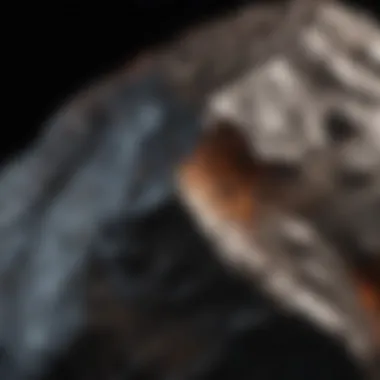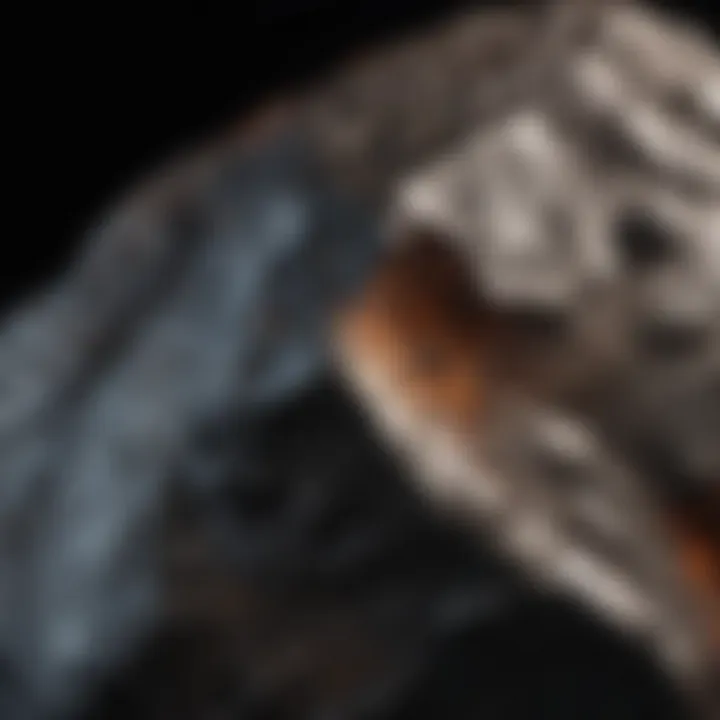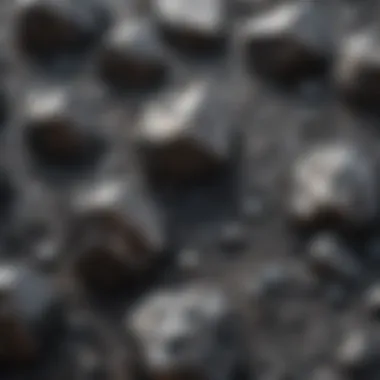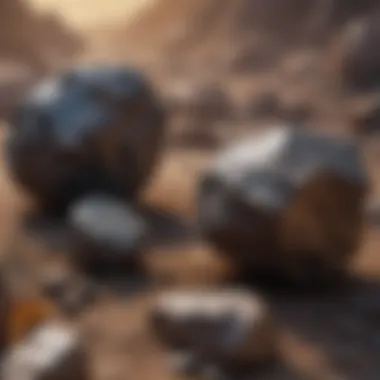Exploring the Visual and Physical Traits of Meteorites


Intro
Meteorite rocks, those marvelous fragments of extraterrestrial origin, captivate collectors and geologists alike. Their uniqueness lies not just in their origin from beyond our planet, but also in the varied textures, colors, and structures they exhibit. Understanding these characteristics is crucial for anyone keen on differentiating meteorites from ordinary terrestrial rocks. This article embarks on a journey to explore these aesthetic aspects, shedding light on their classification and significance in geology.
From stony meteorites that resemble common stones to iron meteorites gleaming with metallic luster, each type tells a story of cosmic history. Collectors, enthusiasts, and academic circles stand to gain richly from a comprehensive understanding of these stone treasures. In this exploration, we aim to enhance awareness about how these celestial visitors contribute not only to our scientific understanding but also to the beauty of geological collections.
Featured Collectible of the Month
Overview
This month, we turn our attention to the exquisite Sikhote-Alin meteorite, a celebrated example of a meteorite that fell in 1947 in the Russian Far East. Known for its stunning iron-nickel composition, the Sikhote-Alin meteorite features a distinctive regmaglypt texture, which can be described as thumbprint-like impressions formed during its fiery passage through the Earth’s atmosphere.
Collectors prize these meteorites not just for their aesthetic appeal but also for their intriguing history and classification. Displayed in homes or museums, they serve as striking conversation pieces, revealing the story of our universe in ways that resonate deeply with enthusiasts.
Historical Significance
The Sikhote-Alin meteorite has captured the interest of researchers ever since its fall. Its combination of iron and nickel provides insights into the formation of asteroids, while specific structural features offer clues about the processes that governed its journey through space. Notably, this meteorite is classified as a Pallasite, recognized for its beautiful olivine crystals embedded in a metallic matrix.
The historical context surrounding its fall adds another layer of depth. Eyewitness accounts describe a spectacular fireball lighting up the sky, followed by a series of loud detonations as it broke apart and scattered across the landscape. Such narratives enrich the aesthetic appreciation of this geological specimen.
Identification Techniques
Visual Characteristics
Identifying meteorites can be quite the challenge, but a few key features can help enthusiasts distinguish them from earthly rocks. Here are some aspects to consider:
- Fusion Crust: A smooth, glassy exterior formed when the meteorite heated during atmospheric entry.
- Nickel Content: Most meteorites contain nickel, giving them a metallic sheen that terrestrial rocks rarely exhibit.
- Chondrules: Tiny spherical grains present in some meteorites, forming when molten materials cooled in space.
Keeping an eye out for these features can make spotting a meteorite easier, especially for those new to collecting.
Resources for Identification
Identifying meteorites is not solely reliant on observation; various resources can aid enthusiasts in their quest. Here are a few valuable tools:
- Meteorite Identification Guides: Printed or digital books that outline key characteristics.
- Online Forums: Websites like reddit.com/r/Meteorites offer communities where members share their experiences and tips.
- Social Media Groups: Platforms like Facebook have dedicated groups where collectors exchange insights and identification help.
By utilizing these resources, collectors can refine their identification skills, enhancing both their knowledge and enjoyment of these celestial treasures.
"Understanding the aesthetics of meteorite rocks is not just about beauty, but about connecting with the stories of our universe."
Through examining the visual characteristics and significance of meteorite rocks, we hope to cultivate a greater appreciation for these cosmic artifacts, allowing collectors to forge lasting connections within their collections.
Prelude to Meteorite Rocks
Meteorite rocks stir a sense of wonder that few earthly materials can match. They carry not just the weight of their composition but also the history of our universe, making them critical to both scientific inquiry and personal collections. This section introduces the unique attributes of meteorites and articulates why they command attention in the fields of geology, archaeology, and even art.
Definition and Importance
Meteorite rocks are remnants of celestial bodies that have traversed the cosmos and found their way onto our planet's surface. These fragments might seem like ordinary stones at a glance, but beneath their unassuming exteriors lie tales of stellar birth and cosmic relationships. The importance of meteorites extends beyond their physical appeal; they offer clues to the formation of our solar system and the processes shaping planetary bodies.
For instance, stony meteorites—composed mainly of silicate minerals—tell stories of the early solar nebula, while iron meteorites, rich in nickel and iron, hint at the violent processes of differentiation within asteroids. Such characteristics not only make these rocks fascinating but also invaluable to scientists and collectors alike. The allure of meteorite rocks lies in their rarity and the sense of history they embody. There are unique traits that meteorites exhibit, such as distinct fusion crusts formed when they enter Earth’s atmosphere at blazing speeds.
In essence, meteorites bridge the gap between the cosmos and our terrestrial existence. They help us understand not only the geography of the stars but also our roots in the universe.
Historical Overview of Meteorite Discovery
Meteorite discovery is laden with twists and turns, paralleling humanity's own understanding of the cosmos. From the ancient Egyptians who revered meteorites as celestial gifts to the scientific Community's slow acceptance of these otherworldly materials, the journey is as fascinating as the rocks themselves.
The first recorded meteorite fall in history dates to 1492 in the village of Ensisheim, France. Eyewitness accounts documented a fiery object that crashed to the ground, further stoking human curiosity about these celestial stones. Over the centuries, advances in technology and science have transformed how we study meteorites. The 19th century marked a significant turning point as scientists began to categorize meteorites based on their physical properties and chemical compositions. The establishment of museums dedicated to these artifacts has allowed scholars and collectors to appreciate them deeply.
In the 20th century, with the advent of space exploration, our connection to meteorites grew stronger. Missions to celestial bodies like the Moon and Mars have returned samples, helping to confirm meteorites as pieces of larger cosmic puzzles. Today, with the aid of modern technology like mass spectrometry, distinctions among various types of meteorites become clearer, and our understanding continues to evolve.
The study of meteorites not only fuels our knowledge about the solar system but also ignites a sense of exploration and wonder in all who encounter them.
Through their unique histories and properties, meteorite rocks reflect a rich narrative of our place in the universe, forging a compelling intersection of art, science, and curiosity.
Characteristics of Meteorite Rocks


Understanding the characteristics of meteorite rocks is crucial for appreciating their beauty and significance in geology as well as for collectors. These unique items not only tell the story of their extraterrestrial origins but also reveal the variations that exist due to their formation processes and the environments from which they came. Grasping these characteristics helps in distinguishing meteorites from terrestrial rocks, giving enthusiasts and scientists alike a deeper appreciation for these otherworldly specimens.
Physical Appearance
The physical appearance of meteorite rocks offers an immediate insight into their composition and history. Unlike many earthbound rocks that exhibit familiar shapes and colors, meteorites are often marked by features that are purely out of this world. They may display irregular shapes, unique surface features, and an array of textures that attract both scientists and collectors. Their distinct visual traits are indicative of their formation, journey through space, and interaction with Earth’s atmosphere upon entry.
Surface Texture
Regmaglypts
Regmaglypts are shallow, thumbprint-like impressions found on the surface of many meteorites. These unique features are formed as a result of intense heat and pressure during atmospheric entry. The key characteristic of regmaglypts lies in their ability to provide insights into the meteorite's journey — the more pronounced the regmaglypts, the more violent the entry likely was. This aspect is particularly beneficial for collectors and researchers who seek to determine the meteorites’ trajectory and velocity.
The unique feature of regmaglypts not only adds to the aesthetic value of a meteorite but also serves as a narrative strand, weaving a story of its cosmic voyage. However, one must be cautious, as while pronounced regmaglypts can be a sign of authenticity, they can sometimes be replicated in fraudulent specimens.
Fusion Crust
The fusion crust of a meteorite is a thin, glassy layer that forms as it passes through the Earth's atmosphere. As the meteorite enters at high speed, the outer surface melts and solidifies, creating this striking feature. The key characteristic of fusion crust is its dark, often shiny appearance which stands in stark contrast to the lighter material underneath.
The beauty of fusion crust lies in its reflective quality, making meteorites visually captivating. It's particularly appealing for collectors because an intact fusion crust often signifies a well-preserved specimen. However, one downside to consider is that if damaged, the crust can erode quickly, detracting from both the aesthetic and scientific value of the meteorite.
Color Variations
Meteorites can display a mesmerizing range of colors, influenced by their mineral composition and environmental factors after landing. These color variations are fundamental in distinguishing different types of meteorites, as well as in evaluating their provenance.
Metallic Sheens
Metallic sheens are a captivating aspect of some meteorites, often resulting from the high iron content present in many iron meteorites. This lustrous feature gives them a flashy appearance, making them sought after by collectors. The key characteristic of metallic sheens is their reflective surface, which can change depending on the angle of light. This shimmering quality not only enhances the visual appeal but also serves as a clue to the meteorite’s composition.
The unique feature of a metallic sheen is the depth of color it can add to the art of collection, engaging collectors and enthusiasts alike. However, it’s essential to remember that heavy oxidation can diminish these metallic qualities, leading to rust and potentially impacting the value of the piece.
Rust and Weathering
On the other hand, rust and weathering showcase the meteorites’ history since landing on Earth. Over time, exposure to moisture and air can lead to oxidization, resulting in a reddish-brown hue that can cover parts or the entirety of a meteorite's surface. The key characteristic of rust is that it signifies prolonged terrestrial exposure, providing a fascinating contrast to the otherwise extraterrestrial nature of these rocks.
The unique feature of rust not only tells a story, reminding collectors of the environmental factors influencing them, but also offers possibilities for scientific study on how meteorites interact with Earth’s atmosphere. Yet, while some may find rust adds character, others might see it as a drawback, potentially reducing the desirability of a specimen for purification or aesthetic purposes.
In summary, the characteristics of meteorite rocks extend far beyond their physical appearance, incorporating aspects that reveal their history and identity. Each feature, from regmaglypts to color variations, invites a richer understanding of these celestial specimens.
Classification of Meteorites
The classification of meteorites is a cornerstone of understanding these fascinating extraterrestrial specimens. By categorizing meteorites, we gain insight into their origins, compositions, and the processes that brought them to Earth. Each classification tells a story, revealing the intricate history of our solar system and offering a framework for understanding their visual and physical characteristics.
This is vital for both collectors and scientists alike. Different categories of meteorites present unique aesthetics and features that are captivating to the eye and stimulating to the mind. Knowing how to classify these rocks is an essential skill for anyone interested in identifying or collecting meteorites.
Stony Meteorites
Chondrites
Chondrites are the most abundant type of meteorites and provide a direct window into the early solar system. These meteorites contain small spherical inclusions called chondrules, which are formed from molten droplets that crystallized as the solar system was forming. Their key characteristic, the presence of these chondrules, helps illustrate the processes that transformed dust and gas into the celestial bodies we know today.
Their variability in texture and appearance makes chondrites particularly appealing for collectors. They can range from fine-grained to coarser samples, each offering a different glimpse into their formation. However, because they are so common, discerning collectors might look for rare varieties within this group, which can add an extra layer of allure.
Achondrites
Achondrites, on the other hand, are more differentiated than their chondritic cousins. They lack chondrules and often come from larger asteroids or planetary bodies that underwent significant geological processes. This class of meteorites can hold significant insights into volcanic activity and other geological phenomena beyond Earth.
The absence of chondrules sets achondrites apart, thus giving them a more homogenous and often more appealing look to collectors who appreciate refined aesthetics. They can display intricate mineral patterns and textures that tell a different story, but their relative rarity compared to chondrites may make them more sought-after.
Iron Meteorites
Nickel-Iron Composition
Iron meteorites are primarily composed of nickel and iron, making them some of the most durable and heavy meteorites available. Their distinctive sheen and often intricate crystalline structures are formed through slow cooling processes in space after their formation. This composition is not only key in identifying these meteorites but also a point of beauty, as the metallic luster sets them apart in any collection.
These meteorites are popular due to their aesthetic appeal and the ease of distinguishing them from stony varieties. Collectors enjoy the classic metallic look and may find pieces that exhibit fascinating Widmanstätten patterns—crystalline structures formed during their slow solidification. However, due to their weight, they can be less practical for display purposes than lighter stones.
Grove Patterns
Grove patterns are a hallmark of many iron meteorites. These are typically seen in the surface textures, where striations can create a sense of flow, reminiscent of natural landscapes. The way these patterns form is intimately connected to their cosmic history, providing a dynamic visual impact.


Grove patterns entice both collectors and scientists, showcasing the artistic interplay of nature and cosmic events. It offers a unique narrative, often reflecting the journey through space. While they are a stunning addition to any collection, the very patterns that make them fascinating can also make them more sensitive to corrosion if not preserved properly.
Stony-Iron Meteorites
Pallasites
Pallasites are a unique blend of silicate minerals and metallic iron, often characterized by their breathtaking and striking aesthetics. The gem-like olivine crystals suspended within a metallic matrix create a visual appeal that many collectors and enthusiasts find irresistible.
This combination not only captures light beautifully but also tells a story of the formation conditions within the parent bodies—spaces that once housed molten rock and iron. Their rarity adds to their desirability among collectors, making them a prized piece for anyone wanting to showcase their collection. However, due to their delicate structure, care must be taken to avoid damage due to exposure to moisture or corrosion.
Mesosiderites
Lastly, mesosiderites provide a fascinating composite of metal and stony material. They are believed to have formed from the collision of metal-rich and silicate-rich bodies, revealing a splendid mixture that is both visually compelling and scientifically intriguing. They contain a variety of mineral types, giving them a mosaic-like appearance that can vary significantly from one specimen to another.
Collectors often appreciate the diversity of textures and colors found in mesosiderites. This diversity is a double-edged sword; while it makes for an engaging collection, the variations can make accurate identification and classification tricky.
Understanding these classifications illuminates the rich tapestry of meteorite aesthetics and assists in recognizing the importance these specimens hold in the larger context of planetary science and geology. With each classification, we not only appreciate the beauty of these rocks but also grasp the history of our own planet.
Meteorite Identification Techniques
Identifying meteorites requires a blend of keen observation and scientific analysis. This section highlights the significance of meteorite identification techniques, emphasizing how proper identification enriches the understanding of meteorite characteristics and ultimately leads to better appreciation in both scientific and collector communities. By recognizing the methods available, enthusiasts can distinguish meteorite specimens from common terrestrial rocks, deepening their knowledge and collection practices.
Visual Inspection
Visual inspection is the first step in identifying meteorites. This method relies on the observable characteristics of a specimen and is often the most accessible way for collectors to analyze their finds in the field. It involves looking for specific traits that set meteorites apart.
Field Characteristics
Field characteristics include observable features such as shape, weight, and surface patterns. One key aspect of field characteristics is the presence of *regmaglypts*, which are thumbprint-like impressions typically found on the surface of meteorites. These unique indentations form during atmospheric entry and are indicative of an object's extraterrestrial origin. Notably, recognizing these features can help collectors confidently identify and distinguish meteorites from ordinary stones.
On the flip side, field characteristics can sometimes mislead the untrained eye. Not every rock with a unique surface is a meteorite, and thus reliance solely on visual cues might invite errors. Collectors must be cautious, as certain terrestrial rocks like tektites or ventifact stones can mimic some of these traits but do not possess the same origins or properties.
Common Mistakes
When identifying meteorites, many enthusiasts stumble into common mistakes that may spoil their excitement. A prevalent error is the failure to assess the specimen's overall weight. Meteorites, particularly metallic ones, tend to be heavier than typical terrestrial rocks. Skeptical collectors often overlook this obvious characteristic.
Another frequent blunder involves confusing ordinary rocks with meteorite-like features. For instance, some Earth rocks might display fusion crusts, but they lack the internal structure or composition typical of genuine meteorites. This confusion can lead to misidentifying a valuable find. Thus, collectors are encouraged to gain familiarity with the common traits of meteorites, ensuring they are not swept up in surface appearances alone.
Laboratory Analysis
While visual inspection is a solid starting point, laboratory analysis offers a deeper dive into the true nature of a specimen. Employing sophisticated techniques, researchers can extract critical information about a meteorite's composition and origins.
Optical Microscopy
Optical microscopy plays a crucial role in identifying and analyzing meteorites. This technique allows scientists to observe the gemstone-like crystals and mineral grains that make up the meteorite structure under magnification. One benefit is that it provides insight into the cooling history of the rock, revealing whether it cooled slowly in space or rapidly upon entry into the Earth's atmosphere.
The detailed examination can uncover unique features like chondrules or metal flakes, which are often crucial indicators of whether a rock is indeed a meteorite. However, the drawback is that it requires access to lab equipment and expertise that the average collector might not possess, making it less practical for casual enthusiasts.
Mass Spectrometry
Mass spectrometry stands as a powerful technique for analyzing the elemental composition of meteorites. This method measures the mass-to-charge ratio of ions, providing precise elemental concentrations. One of its key advantages is its ability to distinguish between different isotopes, which can reveal the meteorite's origin and history much more effectively than visual methods alone.
However, mass spectrometry can be costly and complex, requiring samples that may be diminished by the process. Therefore, while it offers detailed and specific information about a meteorite, it is often reserved for professional scientists and researchers rather than casual collectors.
Ultimately, both visual inspection and laboratory analysis serve as indispensable tools for those wishing to delve deeper into the fascinating world of meteorites. By understanding these techniques, enthusiasts can better navigate their passion and ensure that they appreciate every find’s unique story.
Collecting Meteorite Rocks
Collecting meteorite rocks is not just a hobby; it’s an intersection of science, history, and art. Enthusiasts or collectors are drawn to these cosmic treasures for various reasons. The beauty they embody, from the unique textures to diverse colors, captures imaginations and hearts. Collectors often seek more than just physical specimens; they look for stories etched in the rock, representing journeys across the universe and history on Earth.
However, as with any pursuit involving natural resources, there are important factors to consider. Understanding the legal and ethical frameworks surrounding meteorite collection can ensure that one is respecting both the law and the integrity of the scientific community.
Legal and Ethical Considerations
Ownership Rights
Ownership rights concerning meteorite rocks can be a nuanced topic. In most jurisdictions, once a meteorite lands and is found, it is considered the legal property of the finder. However, laws can get tricky when it comes to land ownership, federal regulations, or even international treaties. For instance, if a meteorite lands on private property, the landowner might claim ownership of the meteorite regardless of who discovered it. This aspect underscores the importance of understanding local laws before diving into the collection.


A key characteristic of ownership rights is that they ensure the collector a degree of protection regarding their investment. Owning a meteorite often provides a collector with bragging rights as well as legal standing in disputes, should they arise. However, one must tread carefully here, as acquiring meteorites illegally can result in severe consequences.
It’s beneficial for collectors to understand the provenance of their pieces. Buying from reputable dealers or auction houses helps solidify ownership rights, which contributes to the collector's peace of mind. However, this route might have the disadvantage of higher costs compared with less established sellers.
Trade Regulations
Trade regulations surround the sale and distribution of meteorites, which plays a pivotal role in ensuring ethical practices within the collecting community. Many countries have specific laws that govern how meteorites can be sold, traded, or exported. For instance, in the United States, while meteorites found on private land are typically owned by the finder, selling meteorites from national parks or protected areas is illegal.
A notable aspect of trade regulations is their aim to prevent illegal trade practices that can harm cultural heritage. Collectors benefit from these regulations since they help maintain a level playing field, fostering trust among buyers and sellers. Buyers can feel assured that they're acquiring meteorites that have been legally obtained, which adds to the object’s historical value.
On the downside, trade regulations might also make it more challenging for collectors to access rare specimens. Collectors may find themselves navigating a convoluted maze of laws that can sometimes dissuade them from acquiring a piece they have set their sights on.
Storage and Preservation
Proper storage and preservation of meteorite rocks is crucial to maintaining their beauty and value over time. Given their unique characteristics, meteorites require special handling to guard against degradation.
Temperature Control
Temperature control is vital when it comes to the care of meteorite rocks. Fluctuating temperatures can lead to oxidation and other forms of deterioration, particularly for those meteorites that contain significant amounts of iron. Excess heat can encourage rust, while extreme cold might also adversely affect their structural integrity.
A key characteristic of maintaining optimal temperature is the use of climate-controlled storage spaces. This can be beneficial for both amateur collectors and serious enthusiasts aiming to preserve their collections for future generations. By ensuring a stable temperature, collectors can protect their investments while also retaining the aesthetic qualities of the meteorites.
However, the challenge is that maintaining a controlled environment can lead to additional costs and requires attention. Failing to regulate temperature can quickly turn a well-deserved meteorite collection into a tarnished memory.
Display Cases
Display cases are more than mere containers; they serve as showcases that enhance the aesthetic appeal of meteorites. Well-designed display cases allow collectors to exhibit their specimens without exposing them to damaging elements like dust or humidity. The transparent material used in quality display cases prevents scratches while offering an unobstructed view of the meteorite.
A key attribute of good display cases is that they can be customized. Collectors can choose cases that fit a specific design aesthetic, which can turn a simple collection into an art form. This element of personalization adds a layer of pride to the collection, often emphasizing the unique features of each piece.
However, collectors must be cautious, as not all display cases are equal. Some might not offer adequate protection from UV light or humidity, jeopardizing the preservation of the meteorite inside. Selecting the right display case is crucial to enjoying the beauty of the pieces while preserving their integrity.
Meteorites in Popular Culture
Meteorites have always stirred imaginations and ignited curiosity far beyond the realm of geology. From the very first time a shining rock fell from the sky, humans have been captivated by these extraterrestrial visitors. This section explores the various ways meteorites have impacted art, media, and scientific inquiry, keeping their significance alive in contemporary society.
Influence on Art and Media
Art and media have long drawn inspiration from the striking appearance of meteorites. These celestial objects, often irregular in shape with captivating textures and colors, lend themselves beautifully to various art forms. You might find sculptures crafted from meteorite fragments or paintings that portray their cosmic beauty. Artists like Andy Goldsworthy, who works with natural materials, incorporate meteorites into their installations to evoke the timeless connection between nature and the universe.
Moreover, in films and literature, meteorites frequently serve as harbingers of change or the unknown. Movies like "Armageddon" and "Deep Impact" portray the cataclysmic impact of these rocks, while shows such as "Doctor Who" reference meteorites as conduits for alien life. The fascination doesn't end there. In comic books, characters like Green Lantern showcase meteorites as vital elements tied to power and heroism. This expansive representation in popular culture not only reflects the rock's aesthetic appeal but also our desire to understand our place in the cosmos.
"Meteorites provide a material connection to space, bridging the vast distance between Earth and the universe in a very tangible way."
Their enchanting nature is further explored through the way meteorites are marketed, with many retailers selling meteorite pieces as unique art collectibles. Using social media platforms, enthusiasts share their collections, often highlighting their most stunning specimens, and sparking interest in both the aesthetic and scientific aspects of meteorites among a broader audience.
Scientific Significance Beyond Earth
Meteorites do not solely reside in the artistic realm; their scientific significance is profound and far-reaching. For researchers and scientists, these stones offer a glimpse into the early solar system. By analyzing meteorites, they can unravel the complex processes that governed the formation of planets.
The study of meteorites enables scientists to discover valuable information about the Earth’s geology and the broader cosmic context. For example, some meteorites contain organic compounds, raising questions about the potential for life elsewhere in the universe. The analysis often incorporates advanced techniques, like mass spectrometry, to identify elemental compositions, thus shedding light on the origins of certain meteorites.
The fascination expands when one considers meteorites as a tangible reminder of our interconnectedness with the universe. As we study these fragments from outer space, we are reminded of our fragile existence on Earth. Each meteorite serves as a messenger from the cosmos, containing clues about elements that formed billions of years ago. This prompts deeper curiosity in scholars and hobbyists alike, ensuring that the intrigue surrounding meteorites remains lively and relevant.
Ultimately, the intersection of meteorites with popular culture enhances our appreciation for these fragments from the sky while fueling ongoing scientific exploration. The stories they tell, both in art and research, shape our understanding of the universe and spark a collective wonder that transcends generations.
End
The conclusion serves as the final destination in our exploration of meteorite rocks, tying together the intricate threads of aesthetic appreciation and scientific insight. It’s not just a recap but a vital part of the narrative that underscores the significance of these celestial artifacts in broader contexts. Given the vastness and complexity of the universe, meteorites become tangible windows into the processes that shape not only our planet but also the cosmos. By understanding the aesthetics of meteorites, we become more attuned to their stories.
Summary of Findings
Through this examination, we have unravelled the unique attributes that distinguish meteorites. Key points include:
- Visual Distinction: Meteorites exhibit a range of colors and textures that set them apart from terrestrial stones, such as the striking contrast of fusion crust against the raw metal of iron meteorites.
- Collection Ethics: As collectors, recognizing the importance of legal and ethical practices ensures that our passion for these specimens does not come at a cost to scientific integrity.
- Scientific Value: The physical properties of meteorites offer insights into their origins, contributing to the broader understanding of planetary formation and evolution.
With these findings, it's clear that meteorites are not merely rocks; they’re remnants of history, bridging gaps between different celestial bodies and offering stories of their travels.
Future Perspectives on Meteorites
As we gaze into the future, the role of meteorites in both scientific study and the art world emerges as an area rich with potential. Advancements in technology, particularly in analytical methods, are opening doors to deeper inquiries. For instance, enhanced imaging techniques can reveal subtleties of mineral compositions previously overlooked. The following points highlight potential avenues for exploration:
- Interdisciplinary Research: Future studies could incorporate perspectives from not just geology but also art, biology, and even philosophy, as meteorites beg the question of our place in the universe.
- Collecting Community: The network of collectors can build a more comprehensive community, sharing knowledge and fostering an environment of respect and responsibility towards these natural wonders.
- Public Engagement: Museums and exhibitions could expand their outreach, presenting meteorites in new, immersive ways that blend scientific facts with artistic expressions, captivating a broader audience.
In essence, the aesthetics of meteorite rocks holds not only beauty but also a wealth of knowledge waiting to be unearthed. The continued exploration of these cosmic gems promises not just discoveries but also an opportunity to reflect on our connections to the universe.



